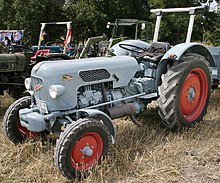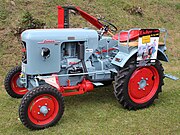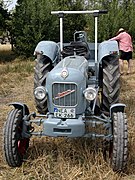Eicher
| Eicher
|
|
|---|---|
| legal form | GmbH |
| founding | 1936 |
| resolution | 2001 |
| Reason for dissolution | insolvency |
| Seat | Forstern , Germany |
| management | Josef and Albert Eicher |
| Branch | Agricultural machinery , commercial vehicles, engines |
Eicher was a manufacturer of tractors , agricultural machinery and engines . The company was founded in 1936 by the brothers Josef and Albert Eicher in Forstern , Upper Bavaria , and went bankrupt for the first time on March 6, 1992. After that, Eicher Landmaschinen Vertriebs GmbH was founded, which had narrow-track tractors produced at MFT in Cunewalde until 2001. The brand name "Eicher" was last used in Europe in 2009 by the Dutch agricultural machinery dealer Hissink & Zonen and is still in use today at Eicher Goodearth in India .
history
1934-1942
Josef Eicher senior, father of the founders Josef Eicher (born in 1906) and Albert Eicher (born in 1907) ran an agency for Opel and Daimler-Benz vehicles in Forstern from 1934 . To make their work easier, the two brothers began in 1935 to attach a knife bar, such as that used to be pulled by horses, to a motor vehicle. However, this solution was not very practical in practice. The Eicher brothers built a three-wheeled tractor themselves in 1935. In this case, however, the individual front wheel was not arranged in the middle, but in a track with the right rear wheel. During demonstrations of the machines on neighboring farms, there was great demand and a great need for tractors. In sequence 1936 built Eicher a first diesel tractor with a 14.7 kW (20 hp) Deutz - diesel engine . The engine was welded to a frame. The rear axle was flanged into this. The gearbox was flanged to the engine and transmitted the power to the rear axle via a cardan shaft. The mower drive went from there via an open chain drive. A year later, in 1937, Eicher was represented for the first time at the DLG exhibition in Munich . The block construction of the Eicher tugs with engines from Deutz and gearboxes from Prometheus prevailed in the following years. More and more tractors were sold, even tractors could be exported to Austria .
Eicher continued to be successful, also because the tugs met the requirements of the Schell Plan . From October 14, 1941, the company traded as Gebr. Eicher Traktorenbau OHG .
1942-1945
During the Second World War , Eicher built tractors with wood gas engines, which made government regulations necessary. Eicher also built metal sleds to transport aircraft engines that were used by BMW in Munich for war production.
1945–1951
After the war, production of pre-war tractors was resumed. In 1948 the first post-war development could finally be presented, the Eicher ED 16 / I. Eicher equipped the tractor with a self-developed engine, the ED 1. The single-cylinder engine developed 11.8 kW (16 hp). The Eicher ED 16 / I was the world's first tractor with an air-cooled diesel engine . The air-cooled engines with separate, axial cooling fans for each cylinder were later to become a distinguishing feature for Eicher tractors. In the following years, the product range was greatly expanded, with the Eicher ED 30 (1949), Eicher ED 25 / I (1950) and Eicher ED 28 (1953) models. The part of the name ED stood for Eicher Diesel . Production also rose steadily. While the 2000 Eicher tractor was built in 1950, the 20,000 Eicher tractor was already completed in 1953.
On July 1, 1951, Eicher acquired Fahrzeug- und Maschinenbau GmbH (Famag for short) in Dingolfing . This enabled the company to produce at a much greater depth, because with Famag they also took over their own foundry . For the time being, Eicher continued the Famag trailer production. The Eicher brothers wanted to set up their own production facility for agricultural machinery. This is how Eicher developed into a supplier of tractors and agricultural machinery. Eicher's slogan developed from this: "A safe deposit for farmers: tractor and equipment from a single source".
The Eicher wheel
As the climax of this successful time, Albert Eicher first succeeded in 1951 in arousing the interest of both the specialist public and the general public with an unusual campaign. The Eicher wheel . The Eicher wheel was shown publicly for the first time in May 1951 at the DLG exhibition in Cologne . The success was sensational. The concept of the Eicher wheel was an Eicher EKL 15, which turned its circles in a loop on its own.
For the Eicher wheel, two circular curved U-rails are set up parallel and perpendicular. These thus form the roadway. An Eicher tractor drives around inside, and on the outside, a counter-chassis connected to the tractor takes on two important tasks: On the one hand, it prevents the tractor from falling in the upper area of the ring of the road, and on the other hand, it is only due to the strong bracing of the tractor with the counter-chassis the necessary contact pressure is generated so that the steep spots on the left and right in the ring can be mastered with the friction between the tire and the road. Some changes were necessary on the tractor. In order to prevent the battery from leaking upside down when driving, it was not used and the engine was started by hand. The fuel tank was pressurized so that the engine can be supplied with fuel even when driving upside down. The Eicherrad has been preserved and is still an attraction at classic car meetings today.
1952-1957
In 1953 Josef and Albert Eicher received the Federal Cross of Merit with ribbon . In 1956 the smallest tractor in the company's history was presented, the EKL 11/2 with a Deutz F1 L 612 engine and 8 kW (11 PS). In 1954, the 44.2 kW (60 hp) Eicher L 60, the most powerful Eicher tractor to date, was presented.
In 1955, the company's first multi-cylinder engine, the ED 2e, came onto the market. It developed 22 kW (30 PS) and together with the ZF A 15 transmission it was installed in the Eicher ED 30. In 1957, the ED 3d, the first Eicher three-cylinder engine, came onto the market. It was sold together with the ZF A 34 transmission as the Eicher ED 50 with 36. kW (50 PS) and with the ZF A 26 as the 44.1 kW (60 PS) Eicher ED 60.
When Renk offered a transmission that made it possible to build an all-wheel drive tractor with four wheels of the same size, Eicher built the Eicher ED 22 all-wheel and Eicher ED 30 all-wheel models. The turning circle of these tugs was very large and the tractor was therefore unwieldy. Since there was no longitudinal differential between the front and rear axles, it was very restless when driving on the road. In addition, the all-wheel drive was permanent. That is why Eicher also sold the tractor as a special machine for use on steep slopes or in the forest.
The first implement carrier was designed by Eicher as early as 1953 . However, it was only produced in series from 1955 and was named Eicher G 16 Kombi. It was built on the basis of the Eicher EKL 15 / II with the Hurth G 85. In 1956, the implement carrier series was expanded to include the Eicher G 13 Muli with the 9.6 kW (13 HP) engine.
1958-1967
In 1958 Eicher revised almost the entire product range and in 1959 brought the completely new series of predators onto the market. The predator series started with the Eicher Panther, Eicher Tiger, and Eicher King Tiger models in 1959 and was supplemented in 1960 by the Eicher Leopard and the Eicher Mammoth. With the predator series, Eicher also began producing narrow-gauge tractors. In 1960 the Eicher Puma was introduced.
Together with the Indian importer Goodearth, Eicher founded a joint venture in 1959 to manufacture Eicher tractors in India. The vehicle manufacturer Eicher Motors emerged from this.
In 1962, the predator series was revised and expanded upwards. The most noticeable change is that the headlights were attached directly to the bonnet.
The second innovation came with the all-wheel drive version Eicher EA 600 of the Eicher Mammut II and in 1963 the Eicher Königstiger all-wheel drive followed. In the years to come, Eicher developed a small truck, the Eicher Farm-Express, especially for road transport. The Farm-Express was presented for the first time in 1962 at the DLG exhibition in Munich. The successor to the Eicher Farm-Express was the Eicher transexpress. This was also built for Magirus-Deutz as the 70 D 6 F from 1966 .
A completely new type of plow robot, the Eicher Agrirobot, attracted a lot of attention in 1964. This plow was able to plow fields on its own with no human supervision whatsoever. The idea was to first make a cross furrow on both sides of the field. Then the Agrirobot should plow the entire field automatically and without disruption. This automatic plow was driven by the Eicher EDK 3 engine with 29.4 kW (40 PS). The vehicle was controlled by buttons at both ends. These ensured that the plow always ran in the furrow and changed direction at the edge of the field. Eicher did not have the financial means to develop the concept sustainably.
In 1966, the implement carrier series was replaced by the new Eicher Unisuper models with outputs of 18.4 kW (25 PS), 22 kW (30 PS) and 29.4 kW (40 PS). As early as 1963, Eicher was experimenting with a continuously variable hydrostatic drive for tractors. The drive was brought onto the market in 1966 in the Eicher Mammut of the 3000 series. Nevertheless, the advertising effect remained more important than the commercial success, not even 100 of all versions of the hydrostatically driven tractor (including the successor types 3019/3020) were sold in the next five years.
1968-1969
In 1968 Eicher completely renewed the standard tractors. The old technology and the predator names remained, but Eicher brought very fundamental innovations. The most important thing was the exterior design. A designer was hired to determine the shape. There was also a new front axle that had independent suspension. The front axle bracket has now been cast. A side switch was installed for ergonomic reasons and because of the appealing shape. A double clutch was also rebuilt, but this had a different functional scheme than the first.
In 1966, BMW acquired Hans Glas GmbH , which in addition to the well-known small cars ( Goggomobil , Isar ) and newer cars ( Glas 1700 , GT , Glas V8 ) also built agricultural machinery under the Isaria brand . The agricultural machinery division and a former glass factory in Pilsting were sold by BMW to Eicher in 1968. Eicher built the agricultural machinery under his own name in Pilsting.
1970-1980
Due to the shrinking agricultural market in the late 1960s, Eicher was looking for a cooperation partner with whom tractor production could continue. Negotiations with Renault and Deutz failed. But in 1970 a contract was signed with Massey Ferguson . In the future, Eicher also built narrow-gauge tractors under the Massey Ferguson brand. Massey Ferguson took a 30% stake in Eicher, which was renamed a GmbH . In the early 1970s, the Dingolfing plant was sold to BMW (see BMW Dingolfing plant ), the Forstern Süd plant to Krauss-Maffei , and production was combined in a new plant in Landau an der Isar and the old Forstern Nord plant. Massey Ferguson held a 49.7% stake in the meantime. The new 74 series has now been equipped with water-cooled diesel engines from Perkins . Perkins was then also a subsidiary of Massey Ferguson. Only the narrow-gauge tractors and the 6-cylinder models continued to be produced with Eicher engines. These models were also offered with MF sheet metal cladding as MF tractors, the 6-cylinder only abroad. Massey Ferguson also held the majority stake in Eicher from 1973 onwards.
Eicher 3002 Mammut HR A with hydrostatic transmission (1966)
1982-1989
1982 Massey Ferguson sold its shares in Eicher to the Indian licensee Eicher Goodearth . Eicher himself held a 23.7% stake in Eicher Goodearth. In the same year, the new Eicher Economy series was presented. Now the tractors had air-cooled Eicher engines again. However, there was no economic success.
Eicher caused a stir for the last time at Agritechnica 1989, when a 108 hp tractor with a three-cylinder engine modified according to the plans of engine designer Ludwig Elsbett was exhibited. It was the first time the Elsbett engine was used in a tractor. The goals were to make the direct-injection engine suitable for vegetable oil and to improve its efficiency. There was optimism about the engine without cooling. The Elsbett-Eicher had neither air nor water cooling, but oil cooling with a huge oil cooler that took up the entire space that was gained by using the three-cylinder instead of the standard six-cylinder engine. Later measurements showed an efficiency about the same as the best conventional diesel engines. But that was only after the bankruptcy of Eicher GmbH in March 1992 and the Elsbett-Eicher was no longer developed for series production.
Also in 1989 a cooperation with Hürlimann began . The series of four models consisted of Hürlimann tractors that were delivered to Germany with the Eicher logo and blue paintwork. The last "Hürlimann-Eicher" were delivered in 1991. A total of about 35 pieces are said to have been delivered.
Since 1990
From 1991 onwards the downfall of the construction of Eicher tractors could no longer be stopped. After the production of standard tractors and engines in Landau was stopped in 1991, the orders for the construction of narrow-gauge tractors were passed on to Cunewalde . Nevertheless, in 1991 the 162,000. Eicher tractor approved.
In 1992 some production facilities had to be sold. The Eicher GmbH again filed for bankruptcy and the Eicher agricultural machinery Vertriebs GmbH was founded. The Eicher narrow-track tractors were built by Motoren- und Fahrzeugtechnik GmbH in Cunewalde until 1998 . After that, the production of Eicher tugs in Germany was stopped. From 2001 the French company Dromson was still building narrow-gauge tractors under the Eicher brand. In 2006 Dromson filed for bankruptcy and the construction of Eicher tugs ended. In 2008, Eicher tractors were again offered at short notice by the brand owner Eicher Landmaschinen Vertriebs GmbH . These were the Eicher 677 and Eicher 777 models, which the former Dutch Eicher importer Hissink Oeken had manufactured at Carraro in Italy. This production also ended in 2009.
literature
- Walter Sack: Eicher - tractors and agricultural machinery. Podszun, Brilon 2005, ISBN 3-86133-381-3
- Kurt Häfner, Michael Karle: Eicher. Tug brochures from 1950 to 1970. Kosmos, Stuttgart 1999, ISBN 3-440-07790-X
- Albert Mößmer: Type atlas Eicher tractors , GeraMond, Munich 2011, ISBN 978-3-86245-645-1
- Albert Mößmer: Eicher - Das Typbuch , GeraMond, Munich 2007, ISBN 978-3-7654-7703-4
- Michael Bruse, Karel Vermoesen: All tractors from Eicher. Types and data volume 1 (standard tractors up to approx. 1960, narrow-track tractors implement carriers)
- Willich Klaus Rabe, 1995, 2nd edition 2002, ISBN 978-3-926071-15-6
- Michael Bruse, Karel Vermoesen: All tractors from Eicher. Types and data volume 2 (standard tractors from 1958), Willich Klaus Rabe, 1998, ISBN 978-3-926071-19-4
- Oliver Aust: Eicher tractors and agricultural machinery , Podszun, 2011, ISBN 978-3-861335-58-0
Web links
Individual evidence
- ^ Walter Sack: Eicher tractors and agricultural machinery , page 7
- ^ Albert Mößmer: Eicher - Das Typbuch , page 8
- ↑ a b Walter Sack: Eicher tractors and agricultural machinery , page 11
- ↑ Albert Mößmer: Eicher - Das Typbuch , page 10
- ↑ Walter Sack: Eicher tractors and agricultural machinery , page 12
- ^ Albert Mößmer: Eicher - Das Typbuch , page 11
- ^ Walter Sack: Eicher tractors and agricultural machinery , page 14
- ^ Albert Mößmer: Eicher - Das Typbuch , page 12
- ^ Walter Sack: Eicher tractors and agricultural machinery , page 15
- ^ Walter Sack: Eicher tractors and agricultural machinery , page 17
- ^ Albert Mößmer: Eicher - Das Typbuch , page 13
- ↑ The Eicher bike is the attraction of the Bulldog friends , at www.mainpost.de , accessed on August 12, 2016
- ^ Albert Mößmer: Eicher - Das Typbuch , page 57
- ^ Albert Mößmer: Eicher - Das Typbuch , page 68
- ^ Albert Mößmer: Eicher - Das Typbuch , page 88
- ^ Walter Sack: Eicher tractors and agricultural machinery , page 124
- ^ Albert Mößmer: Eicher - Das Typbuch , page 178
- ^ Walter Sack: Eicher tractors and agricultural machinery , page 81ff
- ^ Albert Mößmer: Eicher - Das Typbuch , page 25
- ^ Walter Sack: Eicher tractors and agricultural machinery , page 26
- ^ Albert Mößmer: Eicher - Das Typbuch , page 111, 125
- ^ Albert Mößmer: Massey Ferguson - The type book . GeraMond-Verlag, Munich 2010, ISBN 978-3-86245-609-3 , page 91
- ^ Walter Sack: Eicher tractors and agricultural machinery , page 36
- ^ Albert Mößmer: Eicher - Das Typbuch , page 146
- ^ Walter Sack: Eicher tractors and agricultural machinery , page 122f
- ^ Mößmer, Albert: Eicher - Das Typbuch, page 149
- ^ Walter Sack: Eicher tractors and agricultural machinery , page 40
- ↑ Chronicle , on www.eicher- Ersatzteile.eu , accessed on August 12, 2016



















